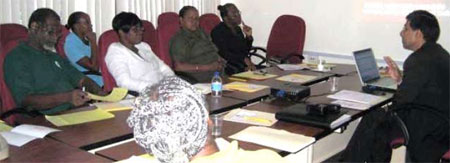 |
 |
 |
|
July 2009
|
Careless Whispers: How misinformation feeds discrimination
The seminar aimed at fostering collaborations and networks with and among stakeholders in Tobago on HIV/AIDS related issues. The audience included health care professionals, HIV/AIDS advocates, stakeholder organisations and representatives from the public and private sector. Among presenters were Dr Derek Chadee, Senior Lecturer and Director, ANSA McAL Psychological Research Centre, Rosanna Yearwood, and Jannel Philip, two MPhil candidates researching HIV/AIDS stigmatization and discrimination. Presentations focused on research pertinent to HIV/ AIDS-related attitudes, in particular HIV/AIDS-related stigmatization. According to the World Health Organization, “stigma and discrimination are the major obstacles to effective HIV/AIDS prevention and care.” Additionally the UNGASS country report for Trinidad and Tobago reported that “Stigma and Discrimination remains pervasive particularly against persons living with AIDS and most atrisk groups and thus create barriers to accessing testing and treatment services.” Dr Chadee’s presentation HIV/AIDS Knowledge Beliefs and Attitudes highlighted findings from research in Tobago such as the role of attitudes in the expression of stigma towards people living with HIV/AIDS. He pointed out misconceptions of modes of HIV/AIDS transmission and the importance of the media (in particular television) in disseminating HIV/AIDS related information. More specifically, the study revealed that the majority (92%) of the sample population thought that people were discriminated against because they have HIV/AIDS. Of the respondents, 31% were unwilling to interact with persons with HIV/AIDS in a social capacity. This included attending social gatherings and eating next to an individual with HIV/AIDS. Furthermore, 35% had negative attitudes towards persons with HIV/AIDS, saying they would not employ the individual, rent an apartment to them or live next door to them. Over 10% of respondents were misinformed about HIV/AIDS transmission via casual contact and interaction. Some of the misconceptions were that HIV can be spread by sharing plates, forks or glasses with someone infected and that HIV/AIDS can be spread by using public toilets. Concerning the impor tance of the media in disseminating information on HIV/AIDS, television and newspapers combined accounted for 70% of HIV/ AIDS information. People got most of their HIV/AIDS information from the television (50%) and newspapers (20%). Jannel Philip’s presentation, Health Care Providers’ Attitudes towards People Living with HIV/AIDS and Perception of Occupational Risk, focused on health care providers’ willingness to treat people living with HIV/AIDS. The research captured the expressed concerns of health care providers for occupational exposure to HIV/AIDS. The availability of resources to deal with accidental HIV exposure as well as providers’ awareness of post exposure prophylaxis and care were other concerns. These concerns influence health care providers’ willingness to interact with patients with HIV/AIDS. Research has shown that health care professionals have a tremendous influence on the physical and emotional welfare of people living with HIV and AIDS. An understanding of health care workers’ concerns is important to improve provider-client relationships. This research hopes to provide an opportunity for dialogue with health care workers to determine these concerns and to subsequently make meaningful contributions towards addressing issues affecting interaction among health care providers and patients living with HIV. Rosana Yearwood’s presentation, HIV/AIDS: Stigmatization, Fear, Perception of Risk and Barriers to HIV Testing, examined how blame contributes to stigmatizing attitudes directed at people living with HIV/AIDS. Fear of contracting HIV/AIDS, and perception of risk of contracting HIV through non viable routes were expressed as two critical factors contributing to the stigmatization. Social and psychological barriers to HIV testing and the stigma that accompanies them were presented as critical elements impeding the reduction of the spread of HIV/AIDS. This study hopes to provide information integral to breaking the cycle of misinformation, fear, blame and stigma. It addresses the psychological barriers to HIV testing. Testing has been sighted as a major factor in fighting the HIV epidemic. Participants asked questions at the end of the presentation and discussions moderated by Father Phil Isaac Chairman of THCCS ensued. Among the attendees were experienced nurses and a doctor, who shared some of their experiences. |

 The ANSA McAL Psychological Research Centre, the Department of Behavioural Sciences, UWI, and the Tobago HIV/AIDS Coordination Committee Secretariat (THCCS) hosted a seminar on HIV/AIDS Stigmatization and Discrimination in June.
The ANSA McAL Psychological Research Centre, the Department of Behavioural Sciences, UWI, and the Tobago HIV/AIDS Coordination Committee Secretariat (THCCS) hosted a seminar on HIV/AIDS Stigmatization and Discrimination in June.